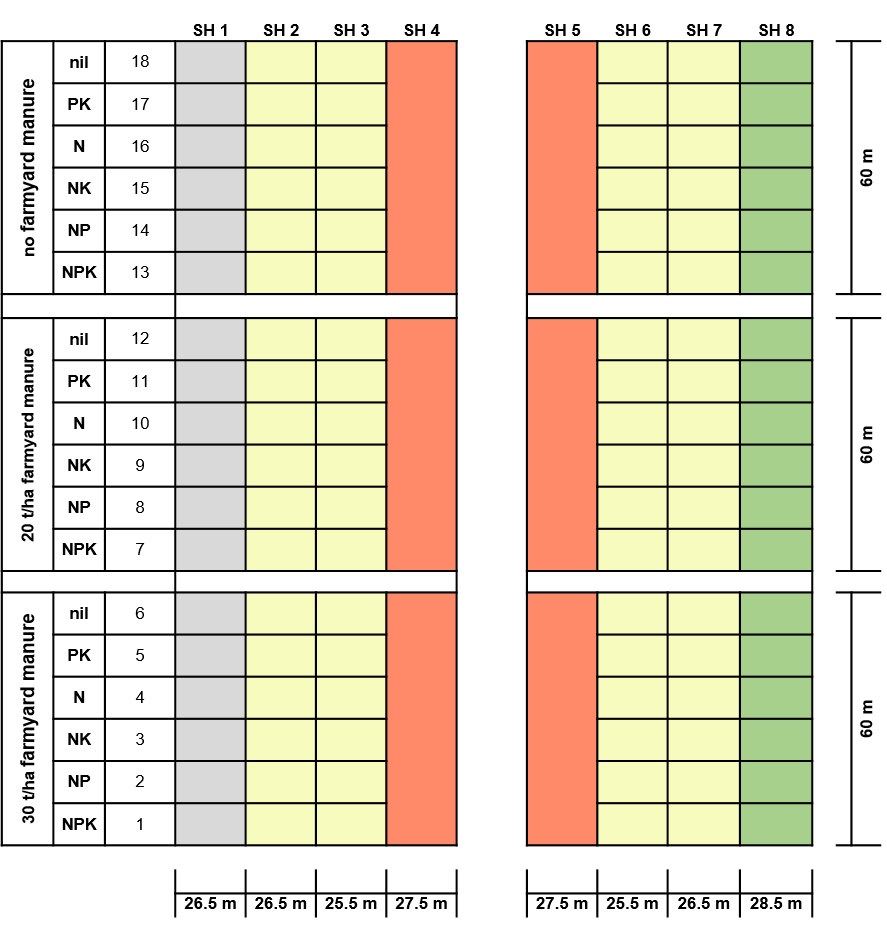Static Fertilization Experiment Bad Lauchstädt

Experiment description
The Static Fertilization Experiment is one of the most valuable long-term experiments in the world. Due to its long duration, variety of applications, special site conditions and the continuity of management it has gained profound importance. The long-standing fertilization has allowed for the establishment of extreme pH gradients and content ranges of Corg, Nt, P(DL) and K(DL). Therefore, the experiment has acquired significance far beyond agricultural research as it is also of great value for fundamental research and the calibration of large-scale equipment. Today the Static Fertilization Experiment is an experimental platform for interdisciplinary environmental research.
The Static Fertilization Experiment is part of the experimental field station of the Helmholtz Centre for Environmental Research in Bad Lauchstädt on the edge of the Querfurt plateau. The soil is a black earth (Chernozem) with a soil value between 94 and 98 (described in detail in ALTERMANNN et al. 2005). The experiment was established in 1902 by Schneidewind and Gröbler. It is 4 ha in size and consists of 8 field stripes, called "Schlaghälfte"(SH). Each field stripe is about 200 m long and between 25.5 and 28.5 m wide (see layout plan). Field stripes 2, 3, 6 and 7 represent the main field stripes, where the experimental treatments have remained almost unchanged over the years, while liming is carried out on field stripe 1 and legumes are integrated into the crop rotation on field stripe 8 since 1924. Field stripes 4 and 5 have been converted over time and represent the so-called Extended Static Fertilization Experiment.
Experimental layout

Layout plan with the 18 fertilization treatments and 8 field stripes (yellow: original treament variants, grey: additional liming, green: integration of legumes, orange: Extended Static Fertilisation Experiment).
Experimental design and crop rotation
The combination of 3 organic and 6 mineral fertilization levels results in 18 test elements, which are systematically arranged. The experimental design is therefore not randomised and - like many old long-term experiments - also has no real replicates. The plots are 10 m long. The plot size varies between 255 and 285 m2 depending on the width of the field stripes. The lack of replicates is compensated for by 4 so-called parallels (a-d) on each plot, i.e. there are 4 harvest plots on each plot. The size of the harvesting plots depends on the crop and the respective harvesting technique. They are currently 1.5 m x 8.3 m for cereals, 2.25 m x 7.6 m for silage maize and 1.2 m x 9.8 m for lucerne.
The crop rotation of the experiment was from 1902 to 2014: sugar beet – summer barley – potato – winter wheat. In 2015, the root crops potato and sugar beet were replaced by maize. The cultivated crop varieties are subject to constant change due to approval procedures
Research question
Originally: Effect of different organic and mineral fertilization on yield and quality of harvests as well as influence of different fertilisation on fertility-determining soil properties - Evidence of sustainable soil use - Quantification C and N cycle
Today: Experimental platform for interdisciplinary environmental research
The basis for this is the time series available over decades for a large number of soil and plant properties.
Miscellaneous
On the north and south side of the experiment there are grass plots in which iron sleeves are encased in concrete for measuring the treatment plots. All corner points of the plots are adjusted by GPS. On the north side of field stripe 1, there is a small concrete area at ground level, which is suitable for soil height investigations with a laser scanner. A station of the German Weather Service has been located in the immediate vicinity of the experiment since August 2017. Data for the period before that were provided by a weather station of the UFZ or by an earlier station of the DWD (until 2006) on the site. Due to these changes only an incomplete data series of measured weather data is available. However, another data series whose gaps were closed with the help of neighbouring stations and with the help of a weather data generator is available as well.
Cooperation and data availability
There is generally great interest in expanding cooperation between scientists at the UFZ and external partners to better utilise the scientific potential of this experiment. Activities in this regard are coordinated by a Scientific Board. Further information on concrete enquiries can be found here.
Additional Information
